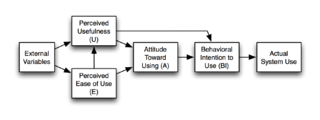
Knowledge management (KM) is the collection of methods relating to creating, sharing, using and managing the knowledge and information of an organization. It refers to a multidisciplinary approach to achieve organizational objectives by making the best use of knowledge.

Innovation is the practical implementation of ideas that result in the introduction of new goods or services or improvement in offering goods or services. ISO TC 279 in the standard ISO 56000:2020 defines innovation as "a new or changed entity, realizing or redistributing value". Others have different definitions; a common element in the definitions is a focus on newness, improvement, and spread of ideas or technologies.
Organizational learning is the process of creating, retaining, and transferring knowledge within an organization. An organization improves over time as it gains experience. From this experience, it is able to create knowledge. This knowledge is broad, covering any topic that could better an organization. Examples may include ways to increase production efficiency or to develop beneficial investor relations. Knowledge is created at four different units: individual, group, organizational, and inter organizational.

Knowledge transfer refers to transferring an awareness of facts or practical skills from one entity to another. That is, the particular profile of transfer processes activated for a given situation depends on (a) the type of knowledge to be transferred and how it is represented and (b) the processing demands of the transfer task. From this perspective, knowledge transfer in humans encompasses an expertise from different disciplines: psychology, cognitive anthropology, anthropology of knowledge, communication studies and media ecology.
Sociotechnical systems (STS) in organizational development is an approach to complex organizational work design that recognizes the interaction between people and technology in workplaces. The term also refers to coherent systems of human relations, technical objects, and cybernetic processes that inhere to large, complex infrastructures. Social society, and its constituent substructures, qualify as complex sociotechnical systems.
Work design is an area of research and practice within industrial and organizational psychology, and is concerned with the "content and organization of one's work tasks, activities, relationships, and responsibilities" (p. 662). Research has demonstrated that work design has important implications for individual employees, teams, organisations, and society.

The technology acceptance model (TAM) is an information systems theory that models how users come to accept and use a technology.
Organizational behavior or organisational behaviour is the: "study of human behavior in organizational settings, the interface between human behavior and the organization, and the organization itself". Organizational behavioral research can be categorized in at least three ways:

Diffusion of innovations is a theory that seeks to explain how, why, and at what rate new ideas and technology spread. The theory was popularized by Everett Rogers in his book Diffusion of Innovations, first published in 1962. Rogers argues that diffusion is the process by which an innovation is communicated thorough certain channels over time among the participants in a social system. The origins of the diffusion of innovations theory are varied and span multiple disciplines.
Coopetition or co-opetition is a neologism coined to describe cooperative competition. Coopetition is a portmanteau of cooperation and competition. Basic principles of co-opetitive structures have been described in game theory, a scientific field that received more attention with the book Theory of Games and Economic Behavior in 1944 and the works of John Forbes Nash on non-cooperative games. Coopetition occurs both at inter-organizational or intra-organizational levels.
Theories of technological change and innovation attempt to explain the factors that shape technological innovation as well as the impact of technology on society and culture. Some of the most contemporary theories of technological change reject two of the previous views: the linear model of technological innovation and other, the technological determinism. To challenge the linear model, some of today's theories of technological change and innovation point to the history of technology, where they find evidence that technological innovation often gives rise to new scientific fields, and emphasizes the important role that social networks and cultural values play in creating and shaping technological artifacts. To challenge the so-called "technological determinism", today's theories of technological change emphasize the scope of the need of technical choice, which they find to be greater than most laypeople can realize; as scientists in philosophy of science, and further science and technology often like to say about this "It could have been different." For this reason, theorists who take these positions often argue that a greater public involvement in technological decision-making is desired.
A contingency theory is an organizational theory that claims that there is no best way to organize a corporation, to lead a company, or to make decisions. Instead, the optimal course of action is contingent (dependent) upon the internal and external situation. Contingent leaders are flexible in choosing and adapting to succinct strategies to suit change in situation at a particular period in time in the running of the organization.
Socio-ecological models were developed to further the understanding of the dynamic interrelations among various personal and environmental factors. Socioecological models were introduced to urban studies by sociologists associated with the Chicago School after the First World War as a reaction to the narrow scope of most research conducted by developmental psychologists. These models bridge the gap between behavioral theories that focus on small settings and anthropological theories.

Culture change is a term used in public policy making that emphasizes the influence of cultural capital on individual and community behavior. It has been sometimes called repositioning of culture, which means the reconstruction of the cultural concept of a society. It places stress on the social and cultural capital determinants of decision making and the manner in which these interact with other factors like the availability of information or the financial incentives facing individuals to drive behavior.
The unified theory of acceptance and use of technology (UTAUT) is a technology acceptance model formulated by Venkatesh and others in "User acceptance of information technology: Toward a unified view". The UTAUT aims to explain user intentions to use an information system and subsequent usage behavior. The theory holds that there are four key constructs: 1) performance expectancy, 2) effort expectancy, 3) social influence, and 4) facilitating conditions.
Innovation management is a combination of the management of innovation processes, and change management. It refers to product, business process, marketing and organizational innovation. Innovation management is the subject of ISO 56000 series standards being developed by ISO TC 279.
The technological innovation system is a concept developed within the scientific field of innovation studies which serves to explain the nature and rate of technological change. A Technological Innovation System can be defined as ‘a dynamic network of agents interacting in a specific economic/industrial area under a particular institutional infrastructure and involved in the generation, diffusion, and utilization of technology’.
Organizational ambidexterity refers to an organization's ability to be efficient in its management of today's business and also adaptable for coping with tomorrow's changing demand. Just as being ambidextrous means being able to use both the left and right hand equally, organizational ambidexterity requires the organizations to use both exploration and exploitation techniques to be successful.
Channel expansion theory (CET) states that individual experience serves as an important role in determining the level of richness perception and development towards certain media tools. It is a theory of communication media perception that incorporates experiential factors to explain and predict user perceptions of a given media channel. The theory suggests that the more knowledge and experience users gain from using a channel, the richer they perceive the medium to be. The more experience, the more stable the knowledge base the person builds, the more knowledge he gains from the given media channel, thus the richer communication he would have using that channel, and ultimately the richer he would perceive the channel. There are four experiential factors that shapes individual's perceived media richness: experience with the channel, experience with the message topic, experience with the organizational context, and experience with a communication partner.
The sociological theory of diffusion is the study of the diffusion of innovations throughout social groups and organizations. The topic has seen rapid growth since the 1990s, reflecting curiosity about the process of social change and "fueled by interest in institutional arguments and in network and dynamic analysis." The theory uses a case study of the growth of business computing to explain different mechanisms of diffusion.





